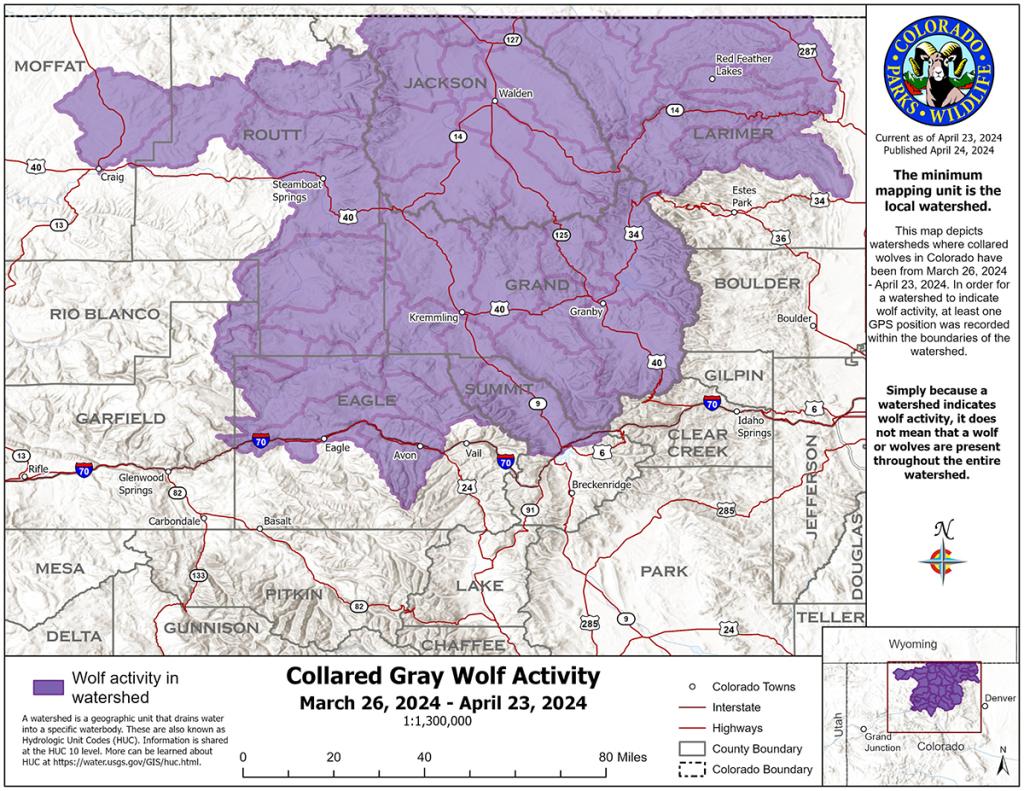CPW releases updated collared gray wolf activity map; launches depredation report webpage


Colorado Parks and Wildlife - Collared Gray Wolf Activity Map - April 2024
CPW also launched a new Gray Wolf Depredation Report webpage to inform the public about confirmed livestock depredations by wolves in Colorado. This page will be updated each time CPW staff investigates and confirms a new depredation event.
Updates:
- This map was created using GPS data from all functioning collars in Colorado.
- Two of the ten collars placed on wolves translocated in December are no longer providing signals to CPW biologists. This includes the collar that failed in March and an additional collar that was partially functional in March but has since failed. The animals with the failed collars are traveling with other animals with functional collars, which currently allows CPW to monitor those animals. CPW has confirmed that the animals with the malfunctioning collars are still alive based on visual confirmation from an airplane.
- Movements of reintroduced wolves have been confirmed in watersheds east of the Continental Divide and onto the Front Range.
- This will be the last press release announcing Collared Gray Wolf Activity Map updates. The website will continue to be updated with recent activity on the fourth Wednesday of every month. Sign up for CPW’s Gray Wolf Reintroduction Enews to stay informed.
- Statement from the U.S. Fish and Wildlife Service: On April 18, 2024, the U.S. Fish and Wildlife Service became aware of a deceased gray wolf in Larimer County, CO. As a federally listed species under the Endangered Species Act, the Service is investigating and has sent the carcass for a necropsy to determine the cause of death. Initial evidence suggests that this wolf likely died of natural causes, but a final determination will not be made until the necropsy is completed. This wolf was one of the ten recently released by Colorado Parks and Wildlife in December 2023, and the Service is working cooperatively with CPW in our investigation. No additional details are available at this time. This is an active investigation, and all inquiries on this topic should go to U.S. Fish and Wildlife Service PIO Joseph Szuszwalak ([email protected]).
- Currently, the collars are programmed to record a position every four hours.
- Once four locations are recorded, the packet of four locations is then transmitted via satellite to CPW biologists.
- Some factors, such as dense cloud cover and closed terrain, can delay the frequency of position recording and data transmission.
- By looking at the data, CPW staff can learn where wolves have been, but they cannot tell where wolves are at a current point in time, nor can they predict where the wolves will go.
- To protect the wolves, specific GPS data will not be shared.
For a watershed to indicate wolf activity, at least one GPS point from the wolf collars was recorded within the watershed's boundaries. Because a watershed indicates wolf activity, it does not mean that a wolf or wolves are present throughout the entire watershed or that they are currently in it.
In order to protect the welfare of the wolves, CPW may buffer public-facing maps during sensitive times of the year (e.g., breeding, denning, or other sensitive times).
Through immigration from other states, potential collar failure or loss, and the natural reproduction of pups, the proportion of wolves with collars transmitting data will be reduced over time. Therefore, the accuracy of this map will diminish over time as the activity of uncollared wolves may not be included in it. The long-term intention is to maintain at least two collars in each pack.
To learn more about wolves in Colorado, visit the CPW Wolves in Colorado website to find a variety of educational materials. Online resources include:
- Living With Wolves brochure
- Producers Guide to Livestock Depredations; Una guía para el productor sobre la depredación del ganado (En Español)
- Coyote or Gray Wolf: How to Spot the Differences flyer
- Wolf Resource Guide: Hands-on Resource to Reduce Depredations
- Keeping your pets safe where wolves are present
###
Colorado Parks and Wildlife (CPW) is an enterprise agency, relying primarily on license sales, state parks fees and registration fees to support its operations, including: 43 state parks and more than 350 wildlife areas covering approximately 900,000 acres, management of fishing and hunting, wildlife watching, camping, motorized and non-motorized trails, boating and outdoor education. CPW's work contributes approximately $6 billion in total economic impact annually throughout Colorado.
DISCLAIMER: The Colorado Parks and Wildlife (CPW) website maintains press releases containing historical information that may no longer be accurate. Press releases are dated, which should be noted to determine whether the information provided is current. Please review our current regulations and brochures for up-to-date information.
 Joey Livingston
Joey Livingston